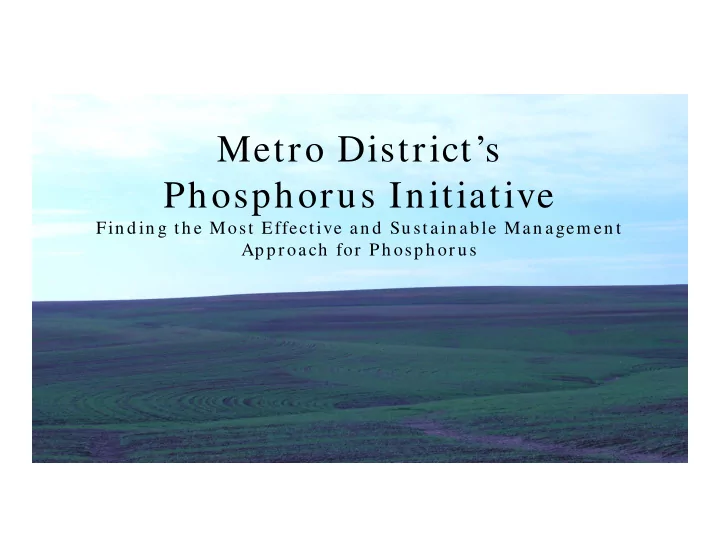

Metro District’s Phosphorus Initiative Fin din g th e Most Effective an d Su stain able Man agem en t Appr oach for Ph osph or u s
Integrated Plan – Regulatory Phosphorus Initiative – Technology /Science Regs Tech. Science 2
Evaluation of Perform ance and Greenhouse Gas Em issions for Plants Achieving Low Phosphorus Effluents Ch r istin e deBar badillo, J am es Bar n ar d, Mar io Ben isch , Mich ael Falk Vol. 15, 20 16, DOI: 10 .2166/ 978 178 0 40 6923 3
The Problem: Why phosphorus is regulated The Cost of Compliance: Financial incentive to figure our way through this The Current Plan Environmental and social reasons for innovation 12 Studies 4
Watershed View Barr-Milton Total Maximum Daily Load Reg. 31 – South Platte River Percent of phosphorus in South Platte River at State line Current annual phosphorus loading 5
Prioritizing Phosphorus Regulation Water Quality Timing 2,500 Barr-Milton Total 0.1 mg/L as measured in In effect Maximum Daily Load Milton Reservoir Effluent Phosphorus, lb/day 2,000 Reg. 85 1.0 mg/L discharged to the Effective 2017 South Platte River 1,500 Reg. 31 0.17 mg/L as measured in 2025 the River 1,000 500 Milton Reservoir 0 2 1 0.2 0.1 Effluent Quality, mg/L 6
Remove Phosphorus from Wastewater
Three P-Removal Steps Biological Phosphorus Removal Filtration Flocculation/Sedimentation 8
Cost-Benefit Capital Cost ($ Mil) Effluent Phopshorus (lb/day) $318M Floc ‐ Sed/Filters = $3,042 Filters = $624 2,168 $198M Bio ‐ P = $56 1,084 $22M 217 108 0 2 1 0.2 0.1 Effluent Phosphorus Concentration, mg/L 9
Biological Phosphorus Removal Biological Basin without Bio ‐ P Biological Basin with Bio ‐ P 10
Phosphorus Accumulating Organisms (PAOs) 11
Initiative Studies/ Goals Biological Removal 1. Full-scale Bio-P Performance 2. Carbon Augmentation 3. Fermentation 4. Sidestream Deammonification 5. Sidestream Bio-P WERF Studies 6. North Secondary Clarifiers Gwynnett Cty, GA Reference Installations Adapted from WEF/WERF Study Quantifying Nutrient Removal Technology Performance, 2011 (NUTRIR06k) 12
Cost-Benefit Capital Cost ($ Mil) Effluent Phopshorus (lb/day) $318M 2,168 $198M 1,084 542 $22M $22M 217 108 0 2 1 0.5 0.2 0.1 Effluent Phosphorus Concentration, mg/L 13
Tertiary Facilities Complex Filter Sedimentation Flocculation & Complex 14
Initiative Studies/ Goals $318M Chemical flocculation sedimentation plus filters Gwynnett Cty, GA Reference Installations Adapted from WEF/WERF Study Quantifying Nutrient Removal Technology Performance, 2011 (NUTRIR06k) 15
Initiative Studies/ Goals $198M Particle Capture (2018) Pilot Evaluation of Tertiary Technology Options Filters Gwynnett Cty, GA Reference Installations Adapted from WEF/WERF Study Quantifying Nutrient Removal Technology Performance, 2011 (NUTRIR06k) 16
Initiative Studies/ Goals Watershed Studies 1. Watershed-based management Strategies 2. Bioavailability of Nutrient Fractions Gwynnett Cty, GA Reference Installations Adapted from WEF/WERF Study Quantifying Nutrient Removal Technology Performance, 2011 (NUTRIR06k) 17
Colorado Phosphorus Index Manage Phosphorus 3 Once It’s Removed 2 1
Three P-Management Steps ACCUMULATE RELEASE RECOVERY Low P Influent •Bio ‐ P organisms •250 mg/L of P •Costs effluent wastewater •Benefits A new recovered resource Adapted from WERF Project NTRY1R12 19
Phosphorus Recovery RECOVERY Evaluation Criteria Enhance mainstream Bio-P reliability Mitigate nuisance struvite on equipment/pipes Achieve chemical and energy savings Reduce phosphorus content in biosolids to help nitrogen land application rates Minimize sludge production Recover a resource for society 20 Adapted from WERF Project NTRY1R12
Potential Yield RECOVERY 21
Initiative Studies/ Goals RECOVERY $30 10-Year Present Value Cost $22M Costs ($ millions) $20 $17M Phosphorus Management $16M $16M $15M (2015-2016) $12M Phosphorus Recovery Evaluation $10 $0 Ferric Magnesium Vendor A Vendor B Vendor B Vendor C (conventional) Reactor (option) Recovery Options Non-Recovery Options 22
Phosphorus Accumulating Organisms (PAOs) K + Mg 2+ K + Mg 2+ 23
Initiative Studies/ Goals RELEASE Phosphorus Management (2016) Struvite Reduction Dewaterability DEWATERING PERFORMANCE STRUVITE FILLING DIGESTERS Improvements Evaluation
Phosphorus Management (2016) RECOVERY Struvite Reduction Dewaterability Improvements Evaluation Before After MgCl 2 6.8ml/L Cake 17.6% 24.6% Polymer 32.2 30.9 lb/DT lb/DT 25
Phosphorus Management (2016) RECOVERY Struvite Reduction Dewaterability Improvements Evaluation Magnesium ‐ Ammonium ‐ Phosphate (MAP) WAS Primary Sludge Digester
Find the Most Effective & Sustainable Management Approach for Phosphorus • Minimize Phosphorus Loading to Receiving Waters • Do it Cost Effectively and Sustainably • Develop an Effective Phosphorus Management Scheme
Discussion
Recommend
More recommend